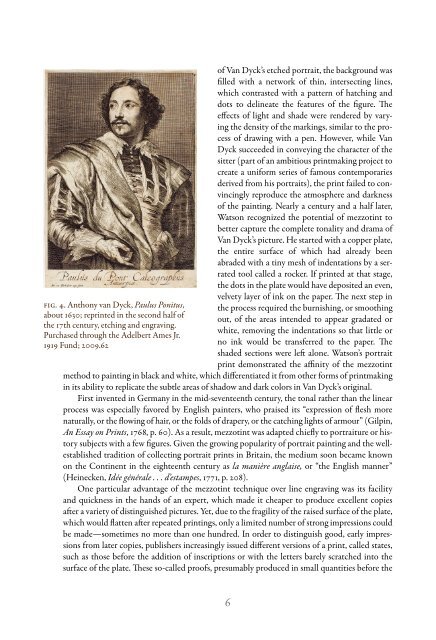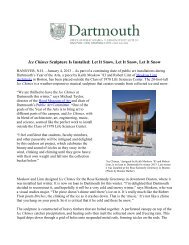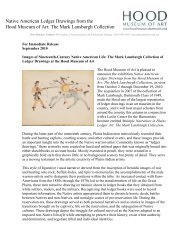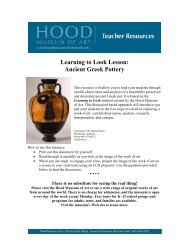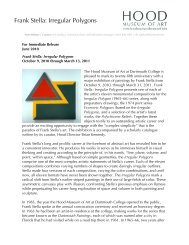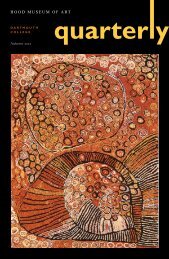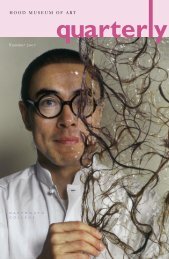The Great Age of English Mezzotints - Hood Museum of Art
The Great Age of English Mezzotints - Hood Museum of Art
The Great Age of English Mezzotints - Hood Museum of Art
- No tags were found...
You also want an ePaper? Increase the reach of your titles
YUMPU automatically turns print PDFs into web optimized ePapers that Google loves.
<strong>of</strong> Van Dyck’s etched portrait, the background wasfilled with a network <strong>of</strong> thin, intersecting lines,which contrasted with a pattern <strong>of</strong> hatching anddots to delineate the features <strong>of</strong> the figure. <strong>The</strong>effects <strong>of</strong> light and shade were rendered by varyingthe density <strong>of</strong> the markings, similar to the process<strong>of</strong> drawing with a pen. However, while VanDyck succeeded in conveying the character <strong>of</strong> thesitter (part <strong>of</strong> an ambitious printmaking project tocreate a uniform series <strong>of</strong> famous contemporariesderived from his portraits), the print failed to convincinglyreproduce the atmosphere and darkness<strong>of</strong> the painting. Nearly a century and a half later,Watson recognized the potential <strong>of</strong> mezzotint tobetter capture the complete tonality and drama <strong>of</strong>Van Dyck’s picture. He started with a copper plate,the entire surface <strong>of</strong> which had already beenabraded with a tiny mesh <strong>of</strong> indentations by a serratedtool called a rocker. If printed at that stage,the dots in the plate would have deposited an even,velvety layer <strong>of</strong> ink on the paper. <strong>The</strong> next step infig. 4. Anthony van Dyck, Paulus Ponitus, the process required the burnishing, or smoothingabout 1630; reprinted in the second half <strong>of</strong>out, <strong>of</strong> the areas intended to appear gradated orthe 17th century, etching and engraving.white, removing the indentations so that little orPurchased through the Adelbert Ames Jr.1919 Fund; 2009.62no ink would be transferred to the paper. <strong>The</strong>shaded sections were left alone. Watson’s portraitprint demonstrated the affinity <strong>of</strong> the mezzotintmethod to painting in black and white, which differentiated it from other forms <strong>of</strong> printmakingin its ability to replicate the subtle areas <strong>of</strong> shadow and dark colors in Van Dyck’s original.First invented in Germany in the mid-seventeenth century, the tonal rather than the linearprocess was especially favored by <strong>English</strong> painters, who praised its “expression <strong>of</strong> flesh morenaturally, or the flowing <strong>of</strong> hair, or the folds <strong>of</strong> drapery, or the catching lights <strong>of</strong> armour” (Gilpin,An Essay on Prints, 1768, p. 60). As a result, mezzotint was adapted chiefly to portraiture or historysubjects with a few figures. Given the growing popularity <strong>of</strong> portrait painting and the wellestablishedtradition <strong>of</strong> collecting portrait prints in Britain, the medium soon became knownon the Continent in the eighteenth century as la manière anglaise, or “the <strong>English</strong> manner”(Heinecken, Idée générale . . . d’estampes, 1771, p. 208).One particular advantage <strong>of</strong> the mezzotint technique over line engraving was its facilityand quickness in the hands <strong>of</strong> an expert, which made it cheaper to produce excellent copiesafter a variety <strong>of</strong> distinguished pictures. Yet, due to the fragility <strong>of</strong> the raised surface <strong>of</strong> the plate,which would flatten after repeated printings, only a limited number <strong>of</strong> strong impressions couldbe made—sometimes no more than one hundred. In order to distinguish good, early impressionsfrom later copies, publishers increasingly issued different versions <strong>of</strong> a print, called states,such as those before the addition <strong>of</strong> inscriptions or with the letters barely scratched into thesurface <strong>of</strong> the plate. <strong>The</strong>se so-called pro<strong>of</strong>s, presumably produced in small quantities before the6


